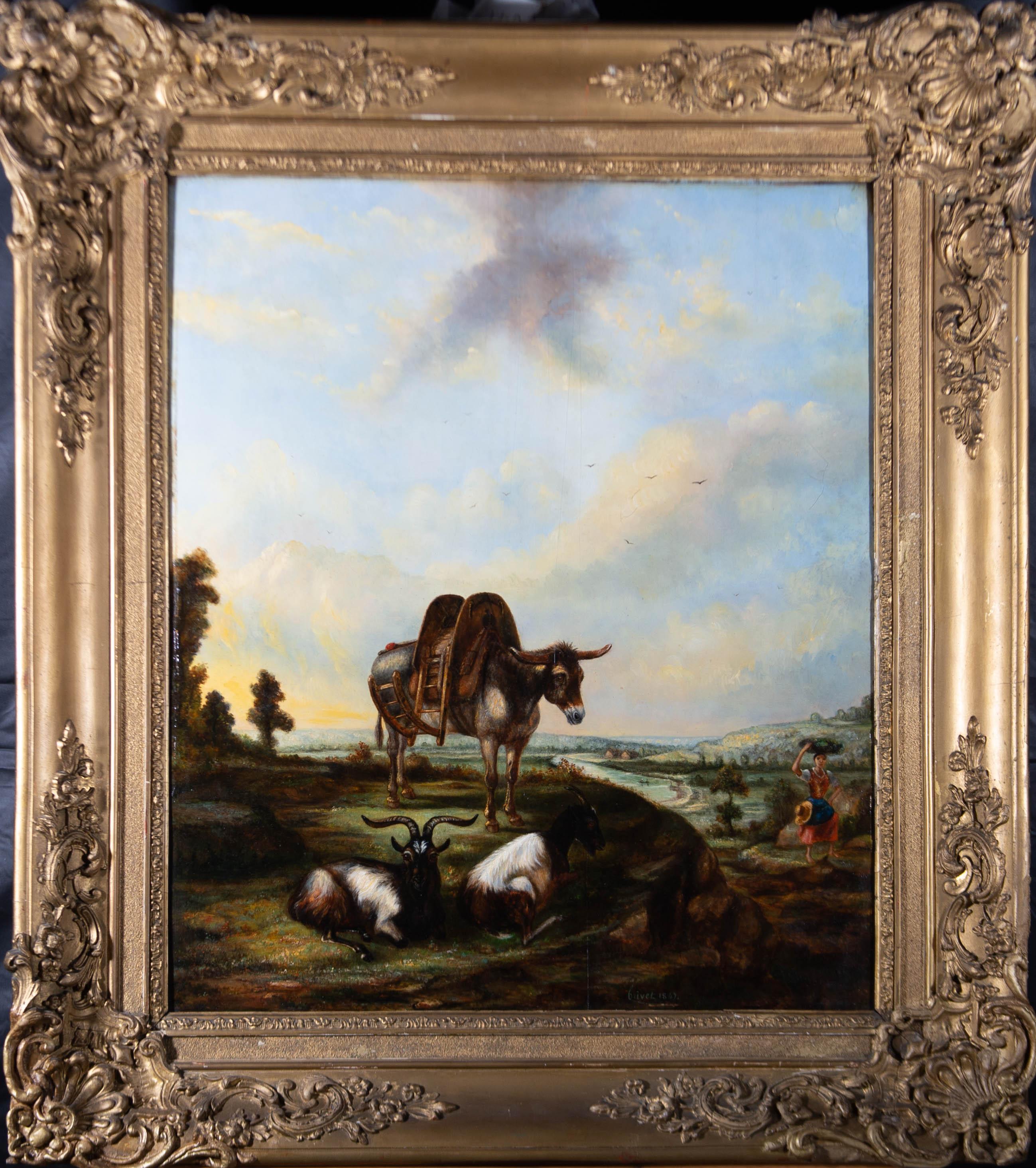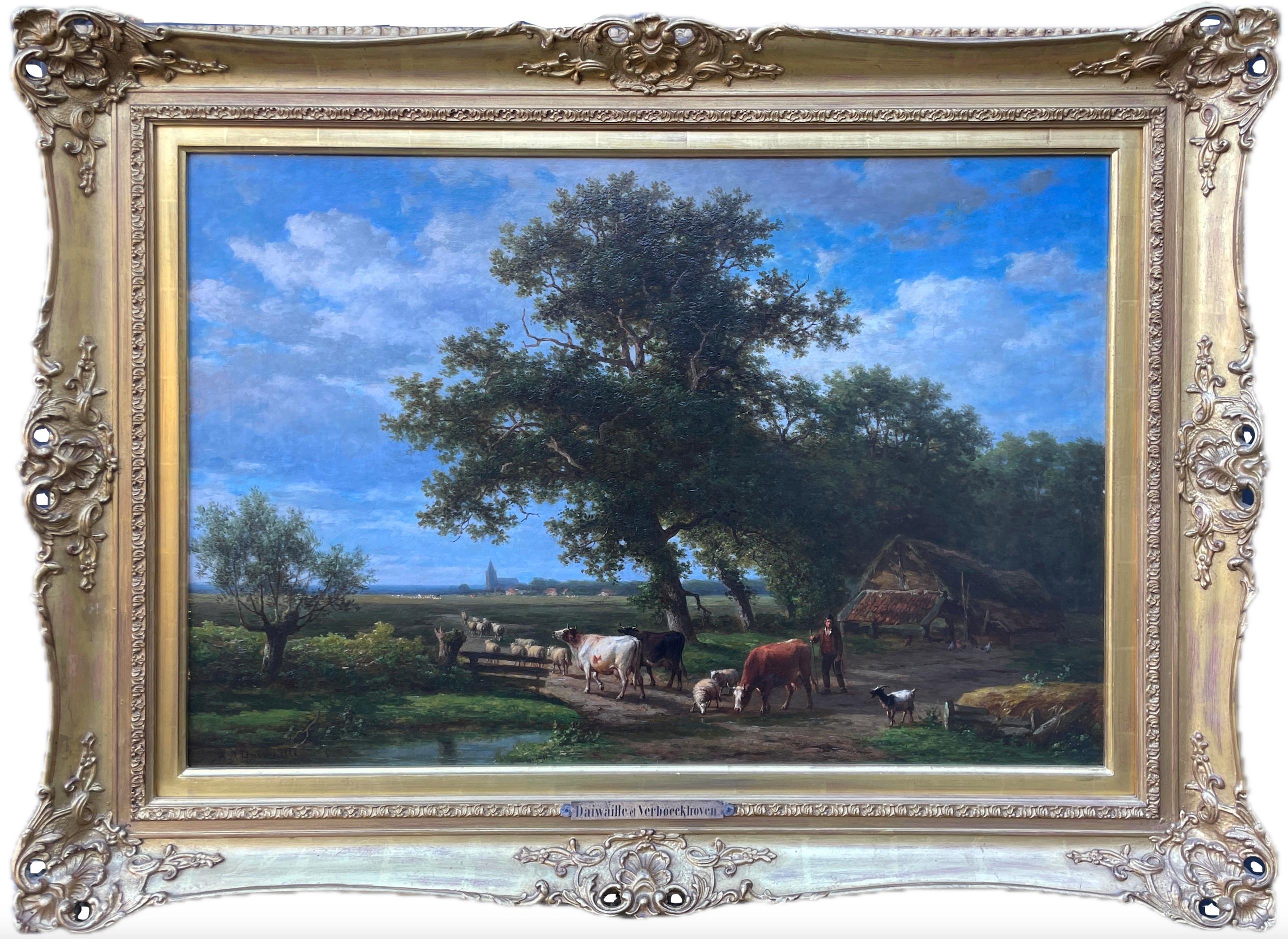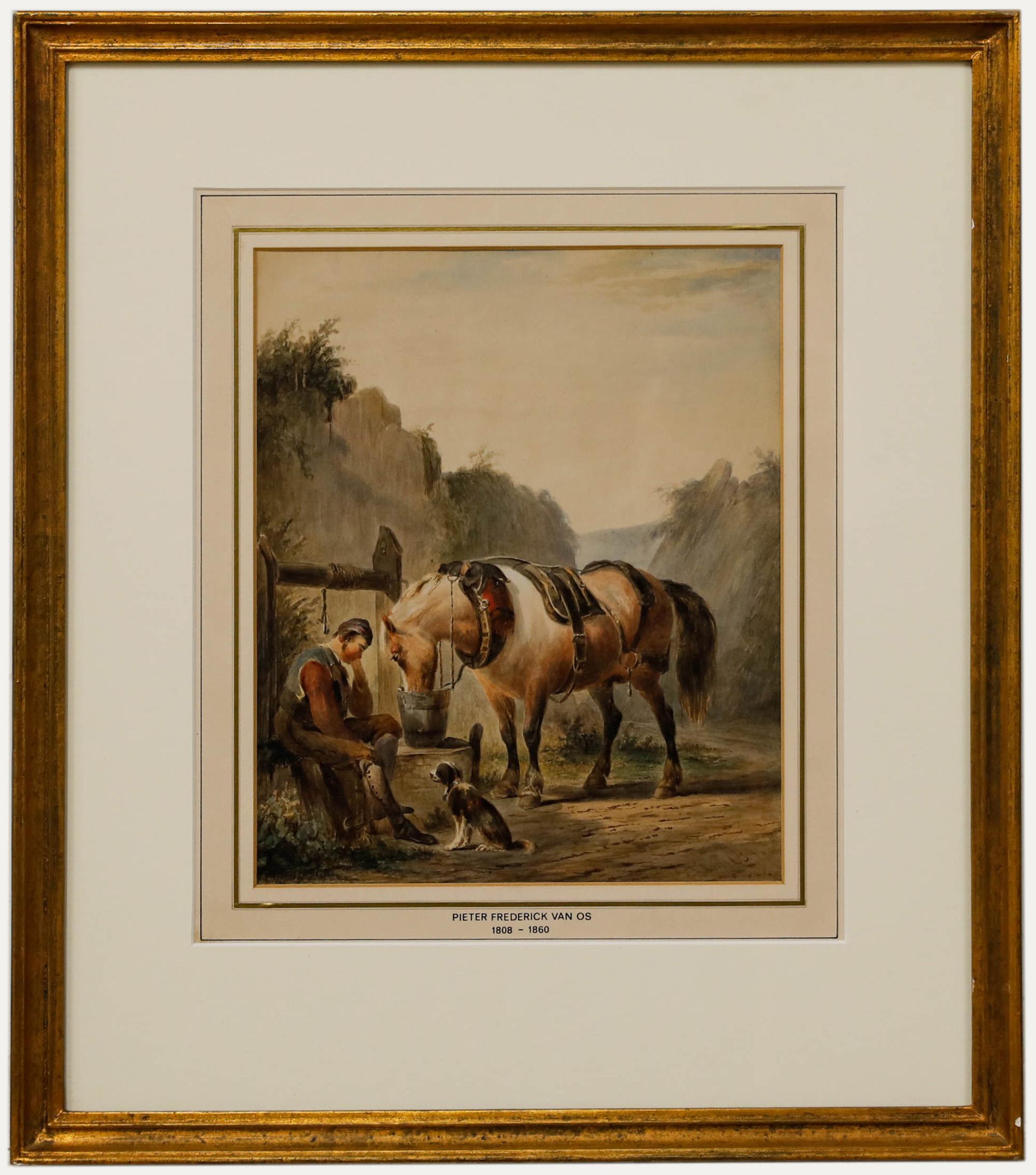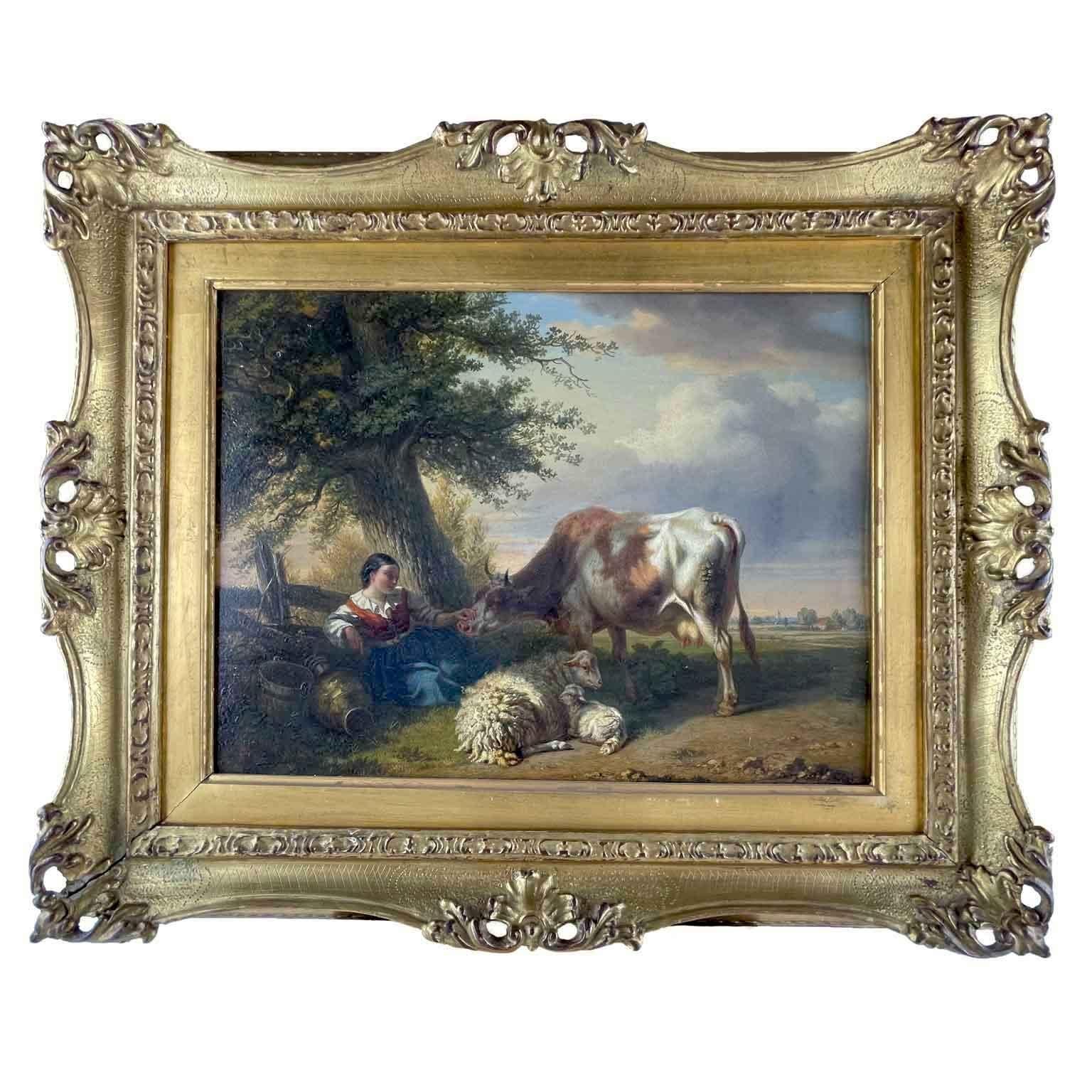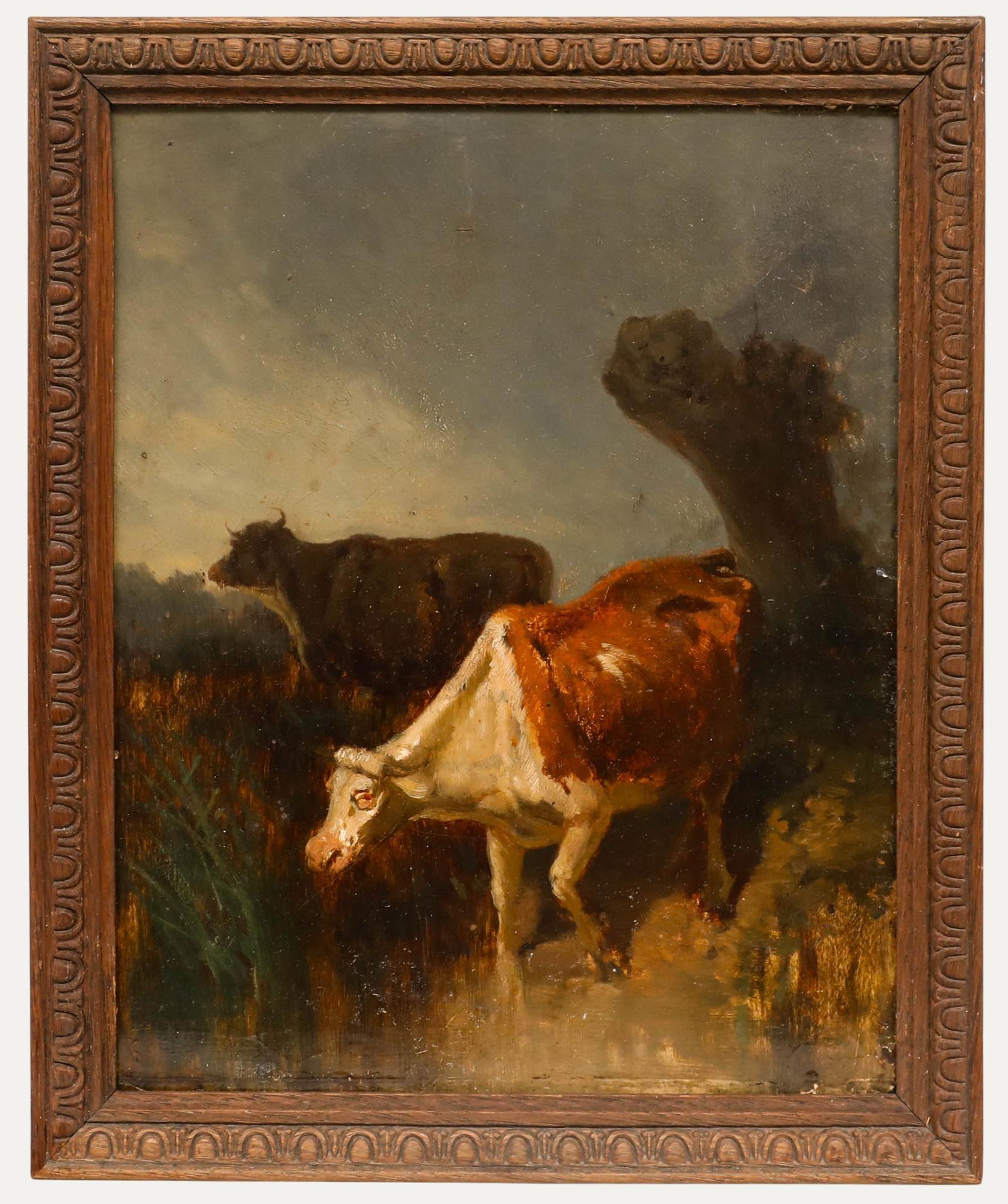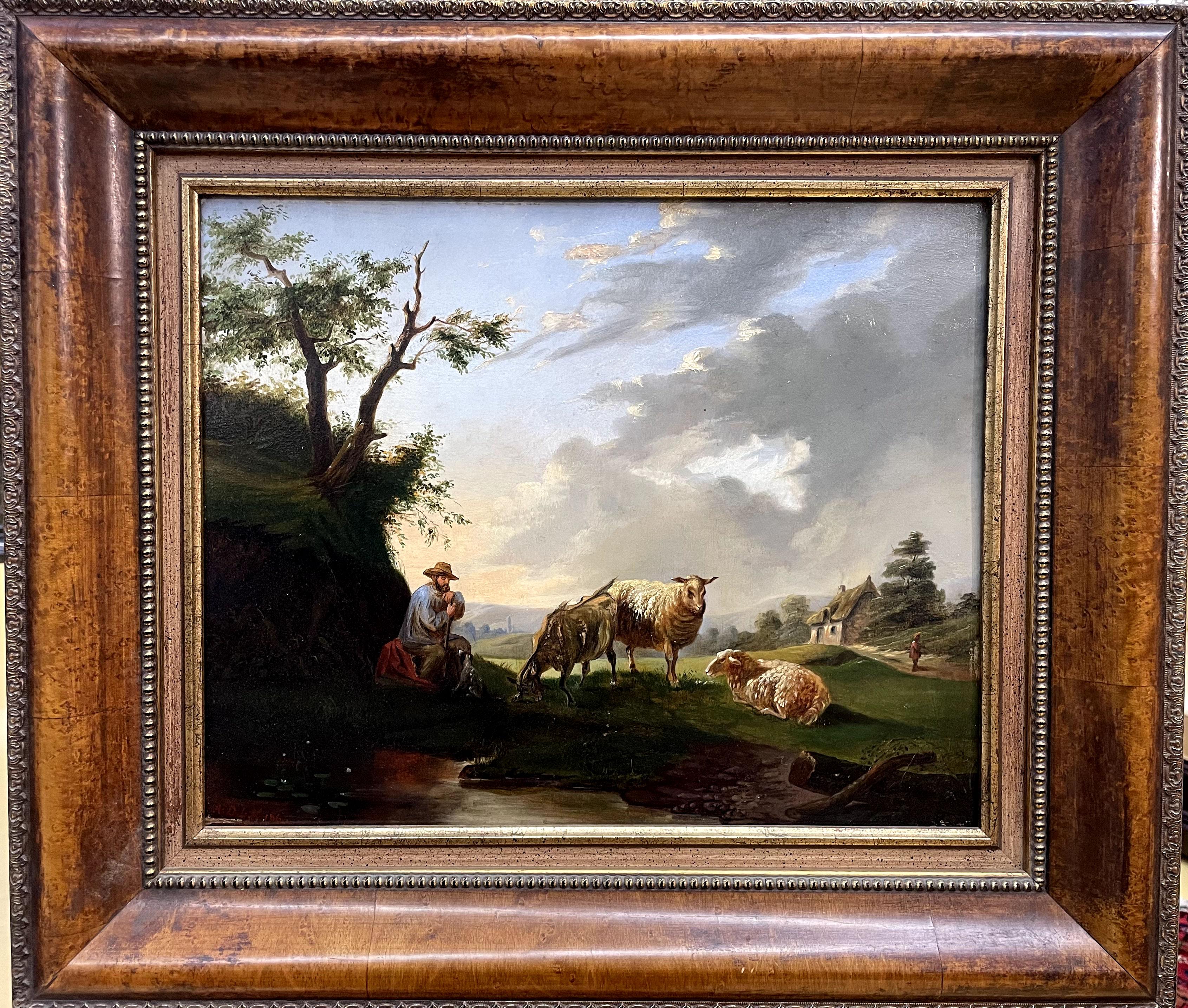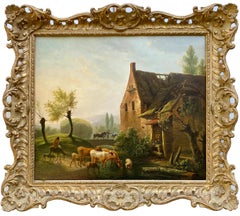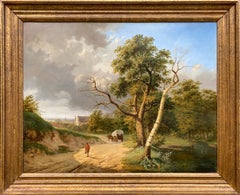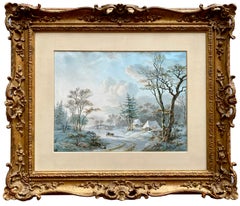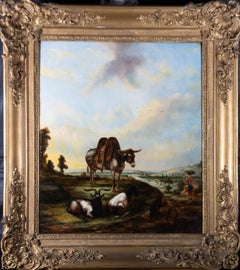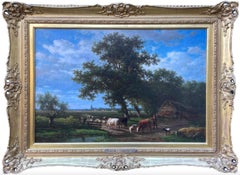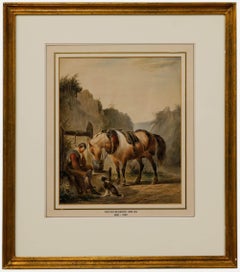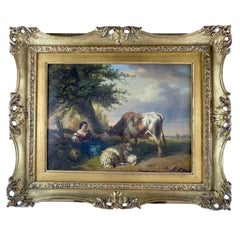Items Similar to 'The Little Donkey' by Eugène Joseph Verboeckhoven (1798 – 1881), dated 1856
Video Loading
Want more images or videos?
Request additional images or videos from the seller
1 of 18
Eugène Joseph Verboeckhoven'The Little Donkey' by Eugène Joseph Verboeckhoven (1798 – 1881), dated 18561856
1856
$40,687.89
£30,224.31
€34,000
CA$56,131.80
A$61,704.29
CHF 32,428.94
MX$749,314.79
NOK 404,542.91
SEK 383,275.96
DKK 258,825.61
About the Item
Eugène Joseph Verboeckhoven
Waasten 1798 – 1881 Schaarbeek
Belgian Painter
'The Little Donkey'
Signature: signed lower left and dated 'Eugene Verboeckhoven 1856'
Medium: oil on panel
Dimensions: image size 23,5 x 32,5 cm; frame size 38 x 46,5 cm
Provenance:
- Illustration in the book "Eugène Verboeckhoven" by P. & V. Berco, Edition Laconti, page 141;
- Private collection, Bavikhove;
- Collection, Berco Fine Art;
- Private collection, Ghent.
Biography: Verboeckhoven Eugène Joseph, a multifaceted Belgian artist born on June 9, 1798, in Warneton, West Flanders, left an indelible mark on the art world through his prowess as a painter, sculptor, etcher, engraver, and lithographer. His oeuvre primarily focused on animals, animated landscapes, and portraits, earning him acclaim and recognition throughout his lifetime and beyond.
Born into an artistic milieu, Verboeckhoven began his artistic journey under the tutelage of his father, Barthélemy Verboeckhoven, himself a sculptor. Early exposure to the world of art laid the foundation for Verboeckhoven’s future accomplishments. He further honed his skills under the guidance of Voituron in Ghent in 1816, setting the stage for a prolific career ahead.
The salons of the early 19th century provided Verboeckhoven with a platform to showcase his talent, and he became a regular participant at prestigious venues such as the Ghent and Brussels Salons. His artistic pursuits took him on journeys across Europe, including visits to the Ardennes, France, Great Britain, Germany, and Italy, where he drew inspiration from diverse landscapes and cultures.
Verboeckhoven’s mastery lay in his ability to capture the essence of nature with meticulous detail and studied composition. He upheld a tradition rooted in the 17th century, emphasizing the observation of nature and the idealized reproduction of reality. Like the Old Masters before him, Verboeckhoven employed traditional techniques such as grinding lapis lazuli for his skies, demonstrating a commitment to craftsmanship and authenticity.
Beyond his role as a painter, Verboeckhoven excelled in other artistic endeavors, including sculpture, etching, engraving, and lithography. His versatility as an artist was matched only by his dedication to his craft, evident in the hundreds of sketches and studies he produced during his lifetime.
Verboeckhoven’s influence extended beyond his own creations, as many artists sought his expertise to enhance their own works with his signature animals and figures. His meticulous preparation and attention to detail set him apart as a consummate artist and a master of his craft.
He was asked to decorate the paintings of an artists such as Jean-Baptiste De Jonghe, Pierre François De Noter, Barend Koekkoek, Edouard Delvaux, Alexander Joseph Daiwaille, Frans Kheelhoff, François Verheyden. Louis-Pierre Verwée and the brothers Charles and Edmond Tschaggeny were his followers.
In addition to his artistic achievements, Verboeckhoven was a respected member of various academies and received numerous honors and accolades throughout his lifetime. Painter died in Schaerbeek. His patriotic services during the Belgian Revolution of 1830 earned him the Croix de Guerre, and he was buried with military honors upon his passing on January 19, 1881.
Eugène Joseph Verboeckhoven’s legacy endures through his timeless artworks, which continue to captivate audiences with their beauty, precision, and depth. As a pioneer of animal painting and a stalwart of artistic tradition, Verboeckhoven remains a celebrated figure in the annals of art history.
Today, his paintings can be found worldwide in private and public collections, including in the Museums of Brussels, Leuven, Antwerp, Liège, Ghent, Courtrai, Lier, Turnhout, Verviers (Belgium), Luxemburg, Valenciennes (Spain), Amsterdam (The Netherlands), Paris (France), Detroit, New York (USA), Saint-Petersburg (Russia).
- Creator:Eugène Joseph Verboeckhoven (1798 - 1881)
- Creation Year:1856
- Dimensions:Height: 14.97 in (38 cm)Width: 18.31 in (46.5 cm)Depth: 3.94 in (10 cm)
- Medium:
- Movement & Style:
- Period:
- Condition:The artwork is elegantly presented in an original frame and is impeccably preserved in excellent condition. This piece is ready for immediate gallery display, having undergone a professional review.
- Gallery Location:Knokke, BE
- Reference Number:1stDibs: LU2006216224072
About the Seller
5.0
Vetted Professional Seller
Every seller passes strict standards for authenticity and reliability
Established in 1998
1stDibs seller since 2022
29 sales on 1stDibs
Typical response time: 4 hours
- ShippingRetrieving quote...Shipping from: Knokke, Belgium
- Return Policy
Authenticity Guarantee
In the unlikely event there’s an issue with an item’s authenticity, contact us within 1 year for a full refund. DetailsMoney-Back Guarantee
If your item is not as described, is damaged in transit, or does not arrive, contact us within 7 days for a full refund. Details24-Hour Cancellation
You have a 24-hour grace period in which to reconsider your purchase, with no questions asked.Vetted Professional Sellers
Our world-class sellers must adhere to strict standards for service and quality, maintaining the integrity of our listings.Price-Match Guarantee
If you find that a seller listed the same item for a lower price elsewhere, we’ll match it.Trusted Global Delivery
Our best-in-class carrier network provides specialized shipping options worldwide, including custom delivery.More From This Seller
View All'Landscape with Shepherds and Animals' by Louis - Pierre Verwée ( 1807 – 1877 )
Located in Knokke, BE
Verwée Louis-Pierre
Courtrai 1807 – 1877 Brussels
Belgian Painter
'Landscape with Shepherds and Animals by the Water'
Signature: signed lower right and dated 'L. P. Verwee 1851'
Medium: oil on panel
Dimensions: image size 43 x 52 cm, frame size 58 x 66 cm
Biography: Louis-Pierre Verwee (also spelled Verwée) was born on March 19, 1807, in Kortrijk, Belgium, and died in Brussels in November 1877. He is widely regarded as the leading representative of the Romantic school in Belgian landscape painting, particularly known for his evocative winter scenes and rural landscapes with cattle.
Verwee left school at an early age to pursue his passion for art. He enrolled at the Academy of Fine Arts in Kortrijk, where he studied under Jan Baptiste de Jonghe, a prominent landscape and animal painter. He later continued his artistic training with Eugène Verboeckhoven in Ghent, who would not only become his mentor but also a lifelong friend and collaborator. The two artists often worked side by side, and Verboeckhoven occasionally painted the figures and animals in Verwee’s landscapes, to such a degree that their early works are sometimes difficult to distinguish.
Verwee followed Verboeckhoven to Brussels and established himself as a successful landscape and animal painter. His preferred subjects were winter and summer scenes, typically populated with figures and animals. His style, particularly in his early work, was closely aligned with that of Verboeckhoven. Over time, he became known for landscapes that reflected the romantic tradition, with compositions echoing the work of Andreas Schelfhout, Barend Cornelis Koekkoek, Frans Keelhoff, and Johann Bernard Klombeck. His depictions of forests and rivers often employed a dreamy, atmospheric quality that captured the mood and light of nature.
In his later career, Verwee sought artistic innovation but found himself increasingly focused on variations of winter landscapes after 1837. These scenes, popularized by Koekkoek and Schelfhout, were characterized by low-hanging snow clouds, icy waterways, and a cool palette of light blue and metallic grey, creating a moody and intimate ambiance. Occasionally, other artists such as Florent Willems...
Category
Mid-19th Century Romantic Landscape Paintings
Materials
Oil, Panel
Attributed to Pierre-Jean Hellemans, Brussels 1787 – 1845, Oil on oak panel
Located in Knokke, BE
Hellemans Pierre-Jean
Brussels 1787 – 1845
Belgian Painter
A Summer Landscape
Signature: Attributed to Hellemans Pierre-Jean
Medium: Oil on oak panel
Dimensions: Image size 62 x 78 cm, frame size 72,50 x 92,50 cm
Biography: Hellemans Pierre-Jean was born on November 21, 1787, in Brussels.
He was a Belgian pre-romantic painter of landscapes.
He was married with his niece, Jeanne Marie-Joséphine Hellemans (1796-1837). She was a painter of still lifes with flowers and fruits.
Hellemans studied at the Acade...
Category
19th Century Romantic Landscape Paintings
Materials
Oil, Wood Panel
'The Shepherd with his Flock' by Cornelis Van Leemputten ( 1841 – 1902 )
By Cornelis van Leemputten
Located in Knokke, BE
Cornelis Van Leemputten
Werchter 1841 – 1902 Schaerbeek
Belgian Painter
'The Shepherd with his Flock – Le berger et son troupeau'
Signature: signed lower right 'Corn. Van Leemputte...
Category
Late 19th Century Realist Animal Paintings
Materials
Oil, Panel
'A winter landscape with an ox-cart' by Willem De Klerk (1800 – 1876)
Located in Knokke, BE
Willem De Klerk
1800 – Dordrecht – 1876
Dutch Painter
'A winter landscape with an ox-cart on a wooded road near a village'
Signature: signed lower left ‘W. de Klerk f’
Medium: oi...
Category
Early 19th Century Romantic Landscape Paintings
Materials
Ink, Watercolor, Pencil
‘Peasant Children walking the Donkeys’ by Edgar Bundy (1862 – 1922), dated 1885
Located in Knokke, BE
Edgar Bundy
Brighton 1862 – 1922 London
British Painter
‘Peasant Children walking the Donkeys’
Signature: signed lower right and dated ‘Edgar Bundy 1885'
Medium: oil on canvas
Dim...
Category
Late 19th Century Romantic Animal Paintings
Materials
Oil, Canvas
Roaring Deer Stag, Carl Friedrich Deiker, Wetzlar 1836 – 1892 Düsseldorf, Signed
Located in Knokke, BE
Roaring Deer Stag
Deiker Carl Friedrich
Wetzlar, Germany 1836 – 1892 Dusseldorf, Germany
German Painter
Signature: Signed bottom right
Medium: Oil on canvas
Dimensions: Image size 58 x 81 cm, frame size 73 x 96 cm
Biography: Deiker Carl Friedrich was born on April 3, 1836 in Wetzlar. He was a Prussian animal painter. Deiker was specialised in animal genres related to hunting and wildlife. He also illustrated magazines and books on hunting.
Carl Friedrich Deiker was the son of Friedrich Deiker, a painter and drawing teacher at the high school. His older brother, Johannes Deiker, with whom he learned to draw after their father’s death in 1843, was a painter specialising in hunting scenes.
Deiker attended the Hanau drawing Academy, where he was a pupil of the director Theodor Pélissier (1794-1863), and then studied at Johann Wilhelm Schirmer’s studio in Carlsruhe.
In 1859, in the Reinhardswald forest, he collected studies for his large hunting paintings...
Category
19th Century Baroque Animal Paintings
Materials
Canvas, Oil
You May Also Like
Crivet - 1847 Dutch School Oil, Donkey At Sundown
Located in Corsham, GB
A fine example of a Dutch School landscape in oil. A donkey with a load bearing saddle stands on a rocky outcrop by a path with two horned goats lying at ...
Category
19th Century Landscape Paintings
Materials
Oil
$2,051 Sale Price
20% Off
Oil on canvas by Eugene Verboeckhoven & Alexander Daiwaille (1796-1881)
By Eugène Verboeckhoven
Located in Uppingham, GB
Oil on canvas by Eugene Verboeckhoven (1796-1881) & Alexander Daiwaille (1818-1888) Landscape with cattle & sheep on a farm track.
Signed by both artists.
Canvas size: 22" x 31" Fr...
Category
1870s Realist Landscape Paintings
Materials
Oil
$10,435 Sale Price
20% Off
Pieter Frederick van Os (1808-1892) - 20th Century Oil, A Horse Watering
By Pieter Frederik van Os
Located in Corsham, GB
This atmospheric painting depicts a tranquil rural scene, with a figure tending to a draught horse on a dusty path amid towering cliffs. The composition balances the intimate foregro...
Category
20th Century Animal Paintings
Materials
Oil
Flemish Antique Landscape with Pastoral Scene and Animals Tschaggeny 1849
By Charles Philogene Tschaggeny
Located in Milano, IT
Tschaggeny Flemish Pastoral Landscape 1849. The Belgian author in this 19th-century oil on oak panel painting depicts a bucolic scene, a landscape with animals and a shepherdess, of ...
Category
Mid-19th Century Flemish School Animal Paintings
Materials
Oil, Wood Panel
Constant Troyon (1810-1865) - Mid 19th Century Oil, Troupeau de Vache
By Constant Troyon
Located in Corsham, GB
This pastoral oil painting depicts cattle grazing in an overgrown landscape beneath a moody, cloud-filled sky that dominates the upper portion of the composition. The artist employs ...
Category
Mid-19th Century Animal Paintings
Materials
Oil
"Pastoral Landscape with Shepherd and Sheep"
Located in Edinburgh, GB
Unidentified Artist (19th Century)
"Pastoral Landscape with Shepherd and Sheep" (1860)
This idyllic 19th-century oil painting on canvas beautifully...
Category
19th Century Realist Animal Paintings
Materials
Canvas, Oil
More Ways To Browse
Donkey Antique
Joseph Thors Oil Painting
Pioneer Paintings
19th Century Painting Military Portrait
17th Century Oil On Panel Portrait
Donkey Oil Painting
1881 Oil Paintings
De Jonghe
Henner Oil Painting
Hens Oil Painting
Hunt Slonem Blue Bunny
Hunt Slonem Glass
Two Horse Paintings
Wild Horse Painting
English Oil Paintings Dogs
Horse Coach
Horse Painting Old
Hunting Dogs Paintings
